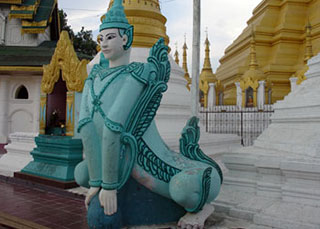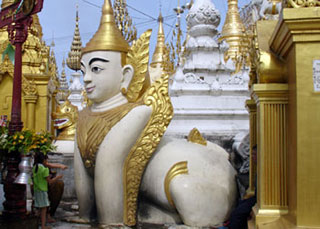The man-lion mythical creature best known in Myanmar is the manussiha. its name is a blend of two Pali words. the first manussa. meaning a human being. and the second siha. a lion. It can be found at each of the four corners of some stupas. a human head and torso on top of the forked haunches of a lion into which the corner of a block like the plinth of a stupa. dovetails snugly. The human head of the modern manussiha can be seen wearing a crown finished with a motif of tier upon tier of upright lanceolate neem leaves tapering off to a pointed finial and ornamented earflaps. the face with regular features composed in a benign. if somewhat wooden attitude. Thus it may be called a sphinx. after a fashion. as the classical Grecian sphinx should be considered female. since it is depicted with a woman’s head and bust on a winged lion while the manussiha is male.


Moreover. the manussiha is said to have originated more than two thousand years ago. According to traditional belief. it is associated with the coming of Buddhist monks Sona and Uttara who brought Buddhism to Suvannabhumi. not too far from modern Thaton. Some say that the name of the royal city was Suddhammavati. while some other authoritative sources say that its name was Taikkala ( from Golamatti in Pali. through Mon-Tuik gala) half of the city was located on top of Mount Kelasa while the rest was on the adjoining plain. Anyway. it was said that the royal city was plagued by ogres who rose from the sea whenever a child was born in the palace. invaded it and carried away the infant to eat.
Just as the monks arrived. it was said. the chief queen gave birth and a contingent of ogresses was soon converging on the palace. However. the monks prevented the ogresses from snatching the royal infant by using their powers to create a monster with a human head and torso on top of the forked haunches of a lion that was twice the size of the ogresses which frightened them and prevented them from carrying out their macabre plan.
It was said that from that day. likenesses of this monster were drawn on various species of palm leaf to be worn as amulets to ward off danger and a stone inscription from the 15th century mentions that a stone sculpture of that monster existed at the northeastern part of the said city on top of the Kelasa mountain right up to the time of its inscription.
The term used in that text. however did not seem to use the term manussiha actually. but it appears in certain Myanmar versions of the original Pali inscription. Moreover. some translations also use the term narasimha for the same monster while others use the term rakkhasimha in referring to it. Narasimha is a Sanskrit term. which is also to be found in Pali made up of nara. meaning man. and simha / siha. denoting a lion . Curiously. the term narasimha / narasiha is more likely to be found in Sanskrit and Pali dictionaries while usage of manussiha seems to be confined to indigenous languages such as Myanmar and Shan.
It also seems to be applied to a creature with the head of a lion on a human torso as it appears in the depiction of the fourth avatar ( incarnation ) of the Hindu god Vishnu. As such it is different from the manussiha man-lion in which the head is that of a man . and not that of a lion. Moreover narasimha is also used as one of the epithets of the Buddha where the comparison with a lion denotes the greatest degree in courage and accomplishments among men.
Some have also attempted to draw a distinction between the two terms for a man-lion by saying that narasiha has a face like one modelled from a death mask while the manussiha is a narasiha decked out in all kinds of ornaments. Still others contend that the monster that the venerable monks created to drive away the ogress was part ogre and part lion . so that it should be termed rakkha siha (Pali- rakkhasa = demon; ogre + siha = lion ie. ‘ogre-lion’ ).
The classical categorization of lions into four kinds in accordance with the Buddhist Scriptures do not include either manussiha or narasiha . However. dictionaries of the Pali language usually carry narasiha as an entry while this does not seem to be the case with manussiha .
From the foregoing. I would like to infer that the term manussiha. although having the meaning of a man-lion in Pali. inasmuch as the term narasimha/ narasiha expresses it in another way. owes its existence to some indigenous writer who referred to this episode in the course of his writings and not finding a term. but a description of the man-lion in the original tract. coined it from Pali stems.This raises another question. why didn’t he use the established term narasiha which meant much the same thing? Was it because though both were combined from parts of man and lion alike. they were of different combinations and as a result. had totally different forms? Or was it because narasiha being an epithet of the Buddha. he might have thought that it could not very well be applied to a monster?
